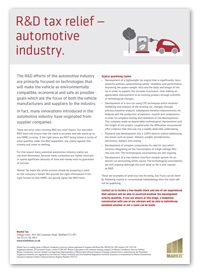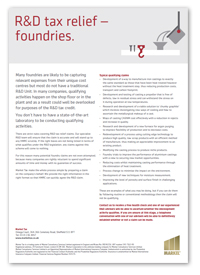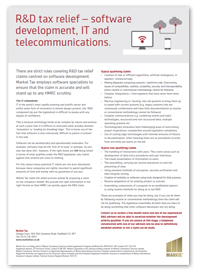Are you eligible for Research and Development (R&D) Tax Relief?

Research and Development (R&D) Tax Relief is one of the UK’s most liberal corporation tax reliefs, yet it remains widely under claimed. It is estimated that thousands of eligible companies fail to claim, and subsequently miss out, on significant tax benefits.
How can PML help you with R&D relief?
We offer a specialist R&D service to clients through our team of qualified accountants and tax experts who have a wealth of industry experience, many of them with additional scientific and engineering qualifications.
A key eligibility requirement for an R&D claim is that a UK company must have been trading for a minimum period of 12 months prior to its first claim. However, once eligibility has been established, we can prepare a claim in the form of a detailed technical report and breakdown of costs which is then submitted to HMRC. We will liaise with HMRC throughout this process to secure acceptance of the R&D claim.
Our service is delivered by working in partnership with Markel Tax, one of the UK’s leading independent specialist tax and funding consultancy firms to the accountancy profession. Furthermore, Markel sits on the HMRC Research & Development Consultative Committee, having worked within that specific area of tax for over 10 years. This experience gives Markel a unique insight and ability to understand what HMRC is looking for, so we are then well-placed to maximise the claim and ensure that this is accepted and processed as smoothly and as quickly as possible.
Below are some case studies showing examples of a successful R&D claim, and also illustrating the range of sectors across which claims can be made;
Case Study: Biotech and Pharmaceutical Industry
Advance:
The advance sought out by the client is the development of CBD derivatives, which are more soluble than CBD, therefore offering better bioavailability. This will also result in lower dosages, and more efficient therapy.
Technological Challenges and Parameters:
There were many uncertainties associated with this project including:
- Designing an array of CBD derivatives that are more soluble than CBD, and have better bioavailability within the body
- Using novel chemistry to synthesise unprecedented CBD derivatives
- Testing the array of CBD derivatives to distinguishing between favourable and non-favourable candidates
- Identifying the most favourable candidates to take to the clinical testing phase of the development
Outcome:
£478,739 of qualifying expenditure was identified, and a successful claim submitted to HMRC, thus achieving a large tax repayment for the client.
Case Study: Construction Industry
Advance:
The advance sought by the client was to create a waterproof barrier to protect the blockwork which was under construction on a uniquely-located site. Access was a problem throughout, as it limited the time in which the operatives could apply the barrier.
Technological Challenges and Parameters:
There were many uncertainties associated with this project including:
- Repeated revisions to the concrete mix to ensure correct drying times
- Using a novel rendering process to create waterproof shield on building
- Concrete warping during the setting process and causing the walls to warp in turn
- Identifying the optimum element of fines within the aggregate used to create the ideal setting rate
- Contending with difficult access to the site, which in turn limited the time available to apply the render.
Outcome:
£ 413,874 of qualifying expenditure was identified, and a successful claim submitted to HMRC, thus achieving a large tax repayment for the client.
Case Study: Coatings Industry
Advance:
The company sought to develop a proprietary coating to be applied to a range of lenses. The coating needed to be impenetrable to blue light whilst also providing clearer vision with no visible tinting.
Technological Challenges and Parameters:
- Establishing a coating capable of blocking out 100% of blue wavelengths between 400nm and 500nm, without impacting on the visual aid provided by the prescription lenses (if applicable), or the clarity of the lenses in general (if non-prescription).
- Ensuring the coating could be consistently applied as a thin layer, across the entire lens, without resulting in uncoated areas through which the light could penetrate.
- Guaranteeing longevity of the coating, with minimal deterioration in filtration, after extensive but normal use.
Outcome:
This small company had a turnover of less than £1m, and received a valuable boost to cash flow in the form of a £29,000 tax saving, and £5,000 tax credit.
Industry Specific Claims:
For further information on R&D tax rules specific to industries please download the PDF documents below:


